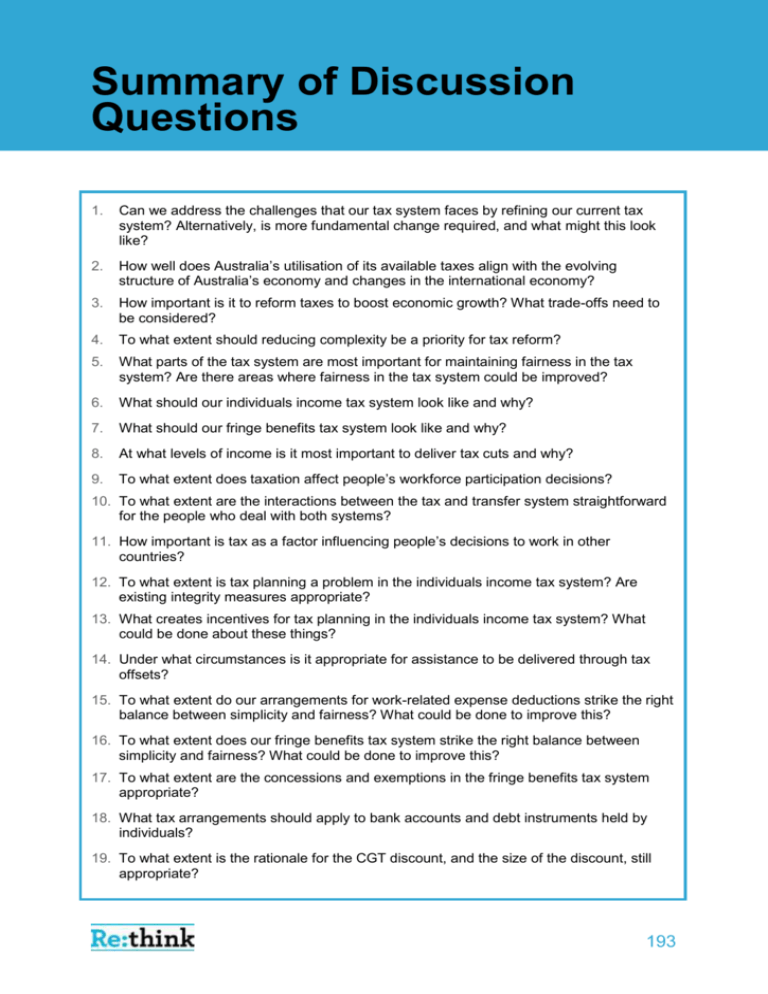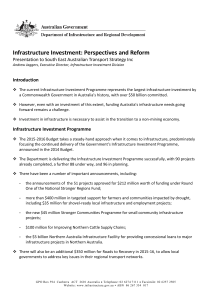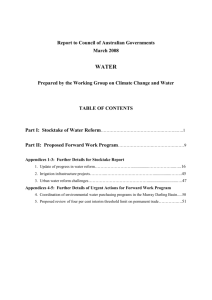Summary of Discussion Questions
advertisement

Summary of Discussion Questions 1. Can we address the challenges that our tax system faces by refining our current tax system? Alternatively, is more fundamental change required, and what might this look like? 2. How well does Australia’s utilisation of its available taxes align with the evolving structure of Australia’s economy and changes in the international economy? 3. How important is it to reform taxes to boost economic growth? What trade-offs need to be considered? 4. To what extent should reducing complexity be a priority for tax reform? 5. What parts of the tax system are most important for maintaining fairness in the tax system? Are there areas where fairness in the tax system could be improved? 6. What should our individuals income tax system look like and why? 7. What should our fringe benefits tax system look like and why? 8. At what levels of income is it most important to deliver tax cuts and why? 9. To what extent does taxation affect people’s workforce participation decisions? 10. To what extent are the interactions between the tax and transfer system straightforward for the people who deal with both systems? 11. How important is tax as a factor influencing people’s decisions to work in other countries? 12. To what extent is tax planning a problem in the individuals income tax system? Are existing integrity measures appropriate? 13. What creates incentives for tax planning in the individuals income tax system? What could be done about these things? 14. Under what circumstances is it appropriate for assistance to be delivered through tax offsets? 15. To what extent do our arrangements for work-related expense deductions strike the right balance between simplicity and fairness? What could be done to improve this? 16. To what extent does our fringe benefits tax system strike the right balance between simplicity and fairness? What could be done to improve this? 17. To what extent are the concessions and exemptions in the fringe benefits tax system appropriate? 18. What tax arrangements should apply to bank accounts and debt instruments held by individuals? 19. To what extent is the rationale for the CGT discount, and the size of the discount, still appropriate? 193 Tax discussion paper 20. To what extent does the dividend imputation system impact savings decisions? 21. Do the CGT and negative gearing influence savings and investment decisions, and if so, how? 22. How appropriate are the tax arrangements for superannuation in terms of their fairness and complexity? How could they be improved? 23. What other ways to improve the taxation of domestic savings should be considered? How could they be applied in the Australian context? 24. How important is Australia’s corporate tax rate in attracting foreign investment? How should Australia respond to the global trend of reduced corporate tax rates? 25. Is the dividend imputation system continuing to serve Australia well as our economy becomes increasingly open? Could the taxation of dividends be improved? 26. To what extent would Australia benefit from the mutual recognition of imputation credits between Australia and New Zealand? 27. To what extent does the tax treatment of capital assets affect the level or composition of investment? Would alternative approaches be preferable and, if so, why? 28. How complex is the tax treatment of capital assets and are the costs of compliance significant? 29. To what extent does the tax treatment of losses discourage risk-taking and innovation and hinder businesses restructuring? Would alternative approaches be preferable and, if so, why? 30. How could the current tax treatment of intangible assets be improved? 31. To what extent should the tax system be designed to attract particular forms of inbound investment (for example, by distinguishing between active and passive or portfolio and non-portfolio)? If so, what principles should inform this? 32. To what extent does the tax treatment of foreign income distort investment decisions? 33. To what extent should the tax system be designed to encourage particular forms of outbound investment (for example, by distinguishing between active and passive or portfolio and non-portfolio)? If so, what principles should inform this? 34. How can tax avoidance practices such as transfer pricing be addressed without imposing an excessive regulatory burden and discouraging investment? 35. Should the tax system provide a more neutral treatment of different financing arrangements (debt, equity and retained earnings), and if so, how? What principles should inform the approaches? 36. Should the tax system provide a more neutral treatment of income earned on revenue account and capital account? Does the distinction create significant compliance costs for business and, if so, how could it be simplified? 37. Are there other important issues in the business tax system, not covered in this section, which should be considered as part of the Tax White Paper process? 38. In what circumstances is it appropriate for certain types of businesses to be subject to special provisions? How can special treatment be balanced with the goal of a fair and simple tax system? 194 Summary of Discussion Questions 39. Does the R&D tax incentive encourage companies to conduct R&D activities that would otherwise not be conducted in the absence of government support? Would alternative approaches better achieve this objective and, if so, how? 40. What other taxation incentives, including changes to existing measures, are appropriate to encourage investment in innovation and entrepreneurship? 41. What effect is the tax system having on choice of business structure for small businesses? 42. What other options, such as a flow-through entity (like an S-Corporation), would decrease the overall complexity and costs for small business involved with choosing a business structure? How would such an entity provide a net benefit to small businesses? 43. Is the interaction of the personal and business tax systems a problem? What can be done to manage the personal-business tax interactions? 44. What are the most significant drivers of tax law compliance activities and costs for small business? 45. How effective is the current range of tax concessions (such as CGT and industry specific concessions) at supporting small business engagement with the tax system? To what extent do the benefits they provide outweigh the compliance, complexity and revenue costs they introduce? 46. What other mechanisms (such as a single lower tax rate, improved technology deployment or other non-tax mechanisms) could assist small businesses to engage with the tax system while decreasing compliance and complexity costs? 47. Are the current tax arrangements for the NFP sector appropriate? Why or why not? 48. To what extent do the tax arrangements for the NFP sector raise particular concerns about competitive advantage compared to the tax arrangements for for-profit organisations? 49. What, if any, administrative arrangements could be simplified that would result in similar outcomes, but with reduced compliance costs? 50. What, if any, changes could be made to the current tax arrangements for the NFP sector that would enable the sector to deliver benefits to the Australian community more efficiently or effectively? 51. To what extent are the tax settings (that is, the rate, base and administration) for the GST appropriate? What changes, if any, could be made to these settings to make a better tax system to deliver taxes that are lower, simpler, fairer? 52. What are the relative priorities for state and local tax reform and why? In considering reform opportunities for particular state taxes, what are the broader considerations that need to be taken into account to balance equity, efficiency and transitional costs? 53. Does each level of government have access to tax revenue bases to finance new spending decisions? If not, should arrangements change to achieve this? How should they change? How important is it that the national government levies taxes on mobile bases? Could some taxes be shared? 54. To what extent does Australia have the appropriate mix of taxes on specific goods and services? What changes, if any, could improve this mix? 195 Tax discussion paper 55. To what extent are the tax settings (i.e. the rates and bases and the administration) for each of these indirect taxes appropriate? What changes, if any, could be made to these indirect tax settings to make a better tax system to deliver taxes that are lower, simpler, fairer? 56. What parts of Australia’s tax system, and which groups of taxpayers, are most affected by complexity? What are the main causes of complexity? 57. Would there be benefit in developing an Australian metric for tax complexity? What factors should be included? How should they be combined into a metric? 58. What system-wide approaches could have the greatest impact on reducing complexity in the tax system? Why have previous attempts to address complexity in the Australian tax system not succeeded? How might it be done in a way that is more successful? 59. In what ways can reforms of tax administration best assist in reducing the impact of complexity on taxpayers? Are there examples from other countries of tax administration reform to reduce the impact of complexity that Australia should adopt? 60. What processes or systems currently being used by businesses and individuals could the ATO better utilise to lower the compliance costs of the tax system? 61. Could administrative responses — such as embracing technology, harnessing data and taking the whole-of-government approach to administration — help address the issue of tax system complexity? 62. Would there be benefits in integrating the administration of taxes across the Federation? If so, what would be required to realise these benefits? 63. What changes could be made to provide greater certainty, transparency and accountability to tax policy development in Australia? 64. Are current tax review arrangements appropriate? How could they be improved? 65. Could the arrangements for developing tax policy in Australia be improved? If so, how? 66. Would the benefits of releasing more tax data and detail around costings outweigh the costs? 196









